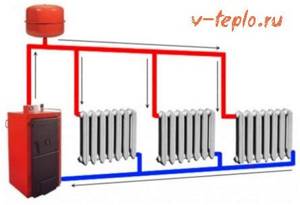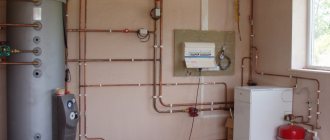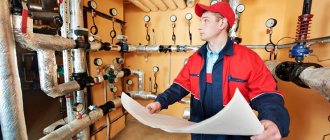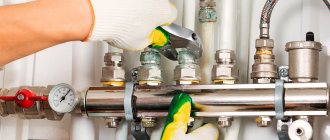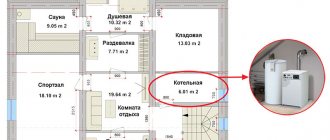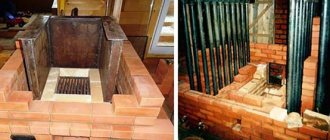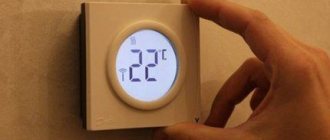Organizing heating in individual country houses and dachas is one of the main tasks of the owner, the solution of which requires significant financial investments and considerable time for work. An important element of the system are heating pipes, the material and physical characteristics of which largely determine the efficiency of the entire pipeline.
When determining which heating pipes are best suited to specific conditions, they consider about a dozen varieties of them made of metals and polymers. Situations often occur when there are different types of heating pipes in one house; for the optimal choice, you should know the basic physical and chemical parameters, installation technology and the preferred area of application of each of them.
Rice. 1 Examples of using pipes for connecting heating radiators
How does it work?
The operating principle of water heating is remarkable for its simplicity. This type of heating is characterized by a closed system, the main elements of which are pipes, radiators and a heating boiler. The heat generator heats up the coolant (water, glycol solution), which, in turn, flows through pipes to radiators installed in heated rooms.
Hot radiators warm up the air due to heat transfer, and a comfortable temperature is established in the rooms. Once cooled, the liquid is returned to the boiler, where its temperature rises and the cycle repeats over and over again.
How does a two-pipe system work?
Unlike the previous one, a two-pipe heating system, the design of which assumes the presence of two pipes: supply and return, is more complex in design. It is designed in such a way that the supply pipe goes directly into each battery, and the return pipe comes out of it. This is also called a parallel device, since all radiators are connected to the boiler using pipes not in order, but in parallel.
A two-pipe heating system, the design of which is more complex, requires more pipes and connecting fittings. Therefore it costs a little more. At the same time, it is more efficient, since all batteries heat up equally, regardless of their location, near the boiler or in the farthest room. This wiring is most often used in two-story houses and cottages.

An important advantage of such a device is that each battery functions almost independently of the others, since it has its own circuit. Therefore, it can be easily replaced or repaired without affecting the rest of the structure. Due to the fact that the two-pipe heating system has a parallel connection scheme for radiators, it is very easy to regulate the temperature and pressure in them, which will provide additional savings in fuel resources.
Helpful advice! When using a heating system with two pipes, it is advisable to use a circulation pump. It will significantly increase the efficiency and heating rate of batteries.
Circulation type
As mentioned earlier, water heating operates by moving coolant through the system. Now we will look at existing types of water circulation, which have fundamental differences that must be taken into account when choosing a scheme.
Natural (gravity)
In this case, the heating process consists of different densities of hot and cold coolant.
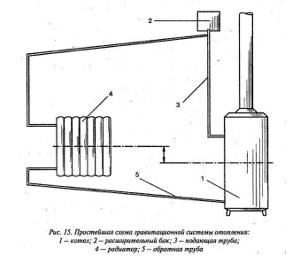
The heated liquid loses its density and decreases in weight, so it is pushed upward, flowing through the pipeline. Having given off heat and lowered the temperature, the water becomes denser, sinks down and goes back into the boiler.
The advantages of a natural water heating system include its autonomy, since it does not require electricity, and a very simple design.
If we talk about the disadvantages, then an impressive number of pipes with a large diameter will be required, otherwise the process of gravity will be disrupted, and modern radiators with a small cross-section simply will not be able to dock with the main line. Also, when installing the pipeline, it is necessary to ensure a slope of 2°, which will facilitate the correct operation of the system.
Forced
Water flows through the pipeline using a circulation pump. The excess coolant mass that forms after heating is discharged into the expansion tank (in most cases a closed design), which prevents evaporation of the liquid.

This rule especially applies to those cases when glycol compounds are used as a coolant. The pressure in forced heating systems must be controlled using a pressure gauge.
The advantages of such a water heating system are very obvious and consist in a small volume of coolant with a low flow rate of pipes, the diameter of which is inferior to the previous option.
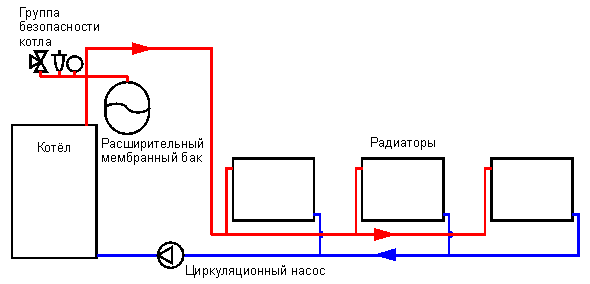
Also here it becomes possible to set the desired heating temperature for radiators, which can be of absolutely any type. The disadvantage is the dependence on the power supply, without which the pump cannot operate.
Heating with forced circulation

So, we see that systems with natural circulation of liquid have a number of rather significant disadvantages. An alternative to them are systems with forced circulation, which use additional equipment that increases the flow of coolant in the system. Namely the circulation pump.
Yes, this type of water heating at home will be more expensive and complex, but you get many advantages:
- Possibility to heat a large room. We have already said that natural circulation is not suitable for large houses. If you are the owner of just such a thing, then your only option is a forced circulation system.
- Complication of the system. By installing a pump, you do not depend on such an indicator as pressure. Therefore, what was an obstacle in a gravity system is not a problem in a forced one. For example, you can now increase the number of pipe bends if the layout of your home requires it.
- Use of smaller pipes. Agree, the neat appearance of the heating system is not the last indicator that is worth paying attention to.
- Less dependence of heating quality on the presence of air in the system. With self-circulation, the entry of air into the system would significantly complicate the transportation of coolant through the pipes. A forced system solves this problem, but in the case of installing metal pipes, special expansion tanks with air vents and fuses should be used in order to avoid corrosion of the system.
- Possibility of using more wear-resistant and lightweight plastic pipes.
- Concealed installation of pipes is possible. You can hide pipes in screeds and walls without any problems.
Equipment
Water heating will be reliable and efficient only if all its parts are correctly selected and installation is carried out correctly. In this case, the elements of the system must interact with each other and match each other by type.
Boiler
The choice of the main heating device is determined by the fuel that will be used to heat the house. According to their type, boilers are:
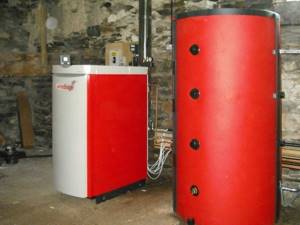
- gas;
- electrical;
- liquid and solid fuel;
- combined.
Devices running on natural gas are rightfully considered the most economical, but they require a pipeline and constant monitoring by special services.
Complete independence from the central energy system can be achieved using solid or liquid fuel, but you will have to come to terms with the concerns of procuring and storing energy resources.
An electric boiler is the least popular, as it consumes a lot of energy and, as a result, incurs high heating costs. In this case, it is better to install radiators that directly convert electricity into heat.

The power of the unit is selected according to the area of the room that will be heated using a water heating system. The selection is made with an average ratio of 1 kW: 10 m², while the height of the walls should be no more than 3 m. You also need to take into account the degree of thermal insulation of the room, the size of the window frames and the presence of third-party heat consumption points.
Highways
Traditional circuit pipes, which are easily susceptible to corrosion, are increasingly giving way to products that do not have such a significant drawback. They were replaced by samples made of galvanized metals and stainless steel.
Copper parts, resistant to sudden changes in pressure and temperature, are rightfully considered the most reliable option. They do not rust and are easily hidden in the wall. Their only drawback is the high cost of the material, which is considered a representative of the premium segment.
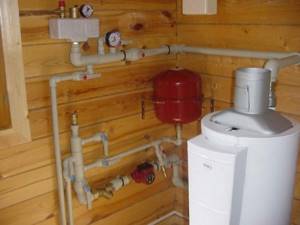
Metal-plastic pipes have a long service life. They have excellent strength, are resistant to corrosion, do not accumulate sediment on the internal walls, their installation is simple, and installation work is carried out quickly.
The disadvantage is the high coefficient of linear expansion during temperature changes, which can lead to damage.
Main advantages
There are many reasons for the popularity of water heating, especially in country houses. Let's take a look at its main advantages together:
- You will be able to quickly and effectively regulate the temperature in each individual room of your home. For this purpose, special equipment is installed - shut-off valves and temperature regulators.
- Such a heating system can be installed in a house at almost any stage of its construction. Moreover, even if the house is completely ready, you will not have any problems installing such a heating system.
- The equipment used for installation can be very diverse.
- The water itself, used here as a coolant, has excellent characteristics. It is cheap and accessible, conducts heat well, and has good heat capacity.
- There are many wiring options for such a system. You can choose one or the other based on many parameters, such as the area of the house or your financial capabilities.
- Such systems are also universal, since almost any fuel can be used with them.
Wiring
Water heating of a private house can be installed in different ways, depending on what types of functions are assigned to it. There are two schemes:
- Single-circuit.
- Double circuit.
One circuit
The first type is designed only for heating the room. It includes a single-circuit boiler with air exhaust, single-pipe wiring and batteries with the required number of sections.

To ensure the supply of hot water, which is used for household needs, two such structures can be installed simultaneously. So, one of them will heat the house, and the second will be solely responsible for the hot water supply. This is a practical solution, since in the warm season there is no point in heating the home in order to obtain warm water for the shower or kitchen.
This design is very easy to assemble and affordable. It is suitable for houses with a small area (up to 100 m²). This explains its popularity among owners of small dachas. Single-circuit water heating can be improved by installing a circulation pump, temperature controllers on batteries and two-pipe wiring.
Two circuits
This wiring principle provides for the simultaneous supply of hot water and heating of the area. Suitable for houses where no more than 4 people live.
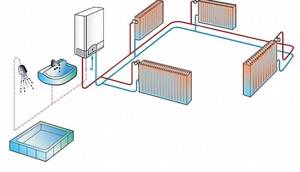
It is worth considering that tap or softened water is suitable here. Hard fluid from the well can damage the system equipment and therefore cannot be used.
Features of the one-pipe system
The easiest way to connect radiators to a boiler is to install a single-pipe heating system. The scheme of this design assumes the presence of only one pipe laid along the entire perimeter of the house. It comes out of the boiler supply pipe and enters the return pipe. From this pipe there are outlets near each radiator, to which it is connected through shut-off valves or directly.
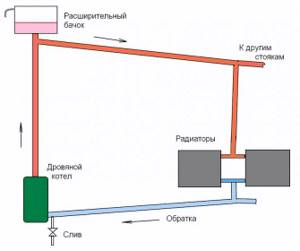
Such a device is not only the simplest, but also the cheapest, both in terms of materials and installation. Using one pipe eliminates the need to make many pipe bends, and much less various small items are consumed. It is no secret that this fittings make up a significant part of the cost of all heating of the house. The use of a single-pipe heating system, the design of which is simple, is justified in small houses with a simple layout of rooms, since the water passes throughout the entire ring and has time to cool significantly. In this regard, the last radiators along its path heat up much less than the first ones. Therefore, if the building is large, then by the end of its route the coolant will lose all its energy and will not be able to heat the last rooms. This is especially true for the natural type of water circulation.
When constructing a single-pipe heating system, the design diagram should assume a slight slope, about 3 - 5 degrees. This will ensure more efficient operation of the entire structure. In addition, all radiators must be equipped with air valves, which are needed to maintain stable pressure in the system by bleeding air. Such taps have small holes and are unscrewed using an ordinary screwdriver.
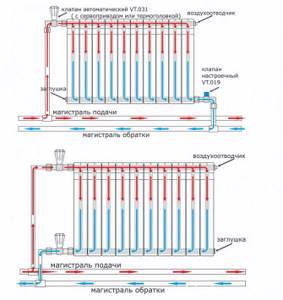
System type
Having become familiar with the methods of coolant circulation through the mains, it is worth knowing that the circuit of a water heating system can be single-pipe, double-pipe or collector. Let's look at all three options in more detail.
One pipe
In this case, the water moves sequentially from radiator to radiator, losing temperature along the way, making each subsequent battery colder.
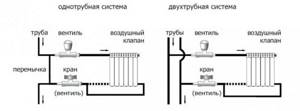
This negatively affects the achievement of a comfortable climate in the rooms.
Two pipes
This scheme is characterized by better heating of the premises. It provides for the installation of two pipes that are connected to each radiator. One of them supplies the batteries with hot coolant, and the second takes the cooled water back to the boiler, so heat loss will be minimal.
Collector
The most effective option, in which a mandatory element is a manifold that separately supplies a pipe with hot water to each heating element. Another pipe returns the cooled coolant back.
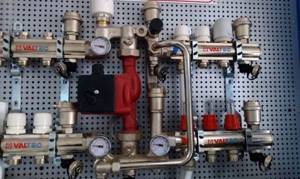
Considering this feature, it is possible to carry out repairs and set the temperature of each radiator separately, without taking the entire circuit out of service. Unfortunately, here the pipe consumption increases significantly and it becomes necessary to install a manifold cabinet.
Pros and cons of water heating systems
Any heating system has advantages and some features that you need to familiarize yourself with in advance so that emergency situations do not arise in the future.
The positive points include:
- all wiring around the house is brought into one place and connected to the boiler. This is much more convenient than installing a heater or stove in every room;
- moderate coolant temperature. With a maximum of 100°C, the battery temperature does not exceed +60°C, in a water floor system - no higher than +40°C. This prevents dust from burning and causing burns upon contact, and the heating of the premises is soft and comfortable.
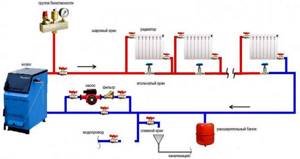
Features of water heating in a private house include:
- preliminary installation of all pipework, which increases the cost of the resource;
- risk of coolant freezing in case of irregular or seasonal use. It is necessary to either drain the water during the absence of residents, or maintain heating during the cold season, or fill in antifreeze;
- risk of leaks.
All water heating systems for a home can be divided into two groups: using natural or forced circulation of water.
Distinctive characteristics
If we compare with air and electric heating, then water heating has firmly taken a leading position due to many factors. First of all, this is an affordable price for materials, work and operation of the system, including payment for spent energy resources, which other types of home heating cannot boast of.
Here we can note the high heat transfer of heating elements, which contributes to uniform heating of rooms and the establishment of a comfortable climate. It is also important that the coolant can be heated using any type of fuel, which is impossible with electric heating.
All work on installing a water system can be easily done with your own hands and this is also a huge plus. With air routes, things are more complicated and, most likely, you will have to turn to specialists for help.
Water heating circuit
The main element of any type of water heating scheme is the boiler. There are many such boilers, and the choice of one or another device depends on a lot of factors - climatic conditions, the ability to use a specific type of fuel, and the personal preferences of the owner of the house. In general, all boilers can be divided into 4 categories:
- On solid fuel.
- On liquid.
- On electricity.
- On gas.
The most common are gas and solid fuel devices, since the fuel for them is relatively inexpensive and available in all regions of the state.
In addition to the boiler, there are other elements of water heating - various types of coils, hollow parts, registers. If we talk about installation, there are no special differences between systems with different types of boilers; you just need to strictly follow the manufacturer’s instructions.
Important! A water heating system allows you to install several different boilers at once. At the same time, it is important that it (the system) be equipped with special automation capable of switching from one unit to another.
